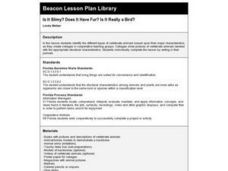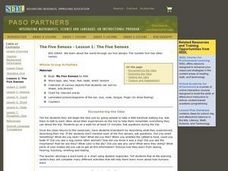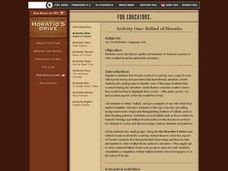Curated OER
Formal Writing Introduction
Give your class tips on formal writing. A paragraph format is outlined along with specifics for writing a conclusion sentence. A few transitions are listed to vary sentences and sentence structure. Pull this resource back out whenever...
Curated OER
Graphing
Intended for a faith-based classroom, this lesson plan requires second graders to create a survey, conduct the survey in multiple classrooms, and graph the results. They can choose between creating a picture or bar graph, or you can...
Curated OER
Shapes and Patterns in Art and Oceans
First graders draw, cut out, and design their own fish shapes by cutting out shapes and putting them together. In this shapes and patterns worksheet, 1st graders also construct a stamp and print patterns with stamps to repeat a...
Curated OER
A Walk Around the School: Mapping Places Near and Far
After reading Pat Hutchins’ Rosie’s Walk, have your young cartographers create a map of Rosie’s walk. Then lead them on a walk around the school. When you return class members sequence the walk by making a list of how the class got from...
Curated OER
Firebird
Elementary schoolers read the Firebird reading list of fantasy and complete discussion questions about fantasy. In this fantasy books lesson plan, young scholars read a list of books and pick one to read.
Curated OER
Treasure Chest Game
Practice spelling rules in a creative manner. Learners practice reading and spelling words with the aw sound. They answer riddles to identify the words with this sound. It is a delightful way to explore this topic.
Biology Corner
Cell Theory Rap
All that this will link you to is a rap about cell theory and organelles. Use it as an example for a creative assignment in your biology class. Divide the class into groups and assign them a topic for which they write and perform a skit,...
Curated OER
Graphs to Represent a Data Set
How many animals did Chaplin see at the zoo? Scholars examine three data sets and create a bar graph for each. Encourage them to label the different parts of their graphs, as this is not prompted on the instructional activity. Once they...
Curated OER
Variation
Students recognize similarities and differences in plants. In this plants and animals lesson, students begin to classify living things by observable characteristics. Students watch clips from the Internet and play online games. Students...
Curated OER
Arctic/Antarctic Animals
Fourth graders explore animals of the Arctic and Antarctic and then create a report. They become aware of the great diversity among animals.
Curated OER
Compost Cake
Young scholars examine the decomposition process. They create their own class compost pile and record their observations. They discover which materials decompose at a different rate.
Curated OER
Under the Sea
Young scholars identify and interpret that non-fiction books have features like a table of contents, a glossary, and an index, which can efficiently help them find information. They also identify how to narrow the search for information...
Curated OER
Fun Activities Using Seeds
Students analyze the size, shape, and form of several different seeds. In this all about seeds lesson plan, students complete four activities involving characteristics of seeds. Students observe the seeds, record information about the...
Curated OER
Do You Need What I Need?
Student identify the basic human needs. In this life science instructional activity, 3rd graders compare the needs of plants, animals and humans. They apply what they have learned by playing a survival team game.
Curated OER
Science Performance Assessment
You can use performance assessments to obtain a richer and more complete picture of what your students know.
Curated OER
Is It Slimy? Does It Have Fur? Is It Really a Bird?
Sixth graders identify the different types of vertebrate animals based upon their major characteristics, as they create collages in groups. Collages show pictures of vertebrate animals labeled with the appropriate structural...
Curated OER
Horns or Antlers-You Decide!
Students study the difference between horns and antlers. They identify animals who have each and draw pictures of these animals. They experience samples of actual horns and antlers.
Curated OER
Amphibians Internet Activity
In this amphibians worksheet, students click on the links in the questions about amphibians to find the answers to the questions and then come back and answer the questions. Students answer 10 questions total.
Curated OER
Reading "Beetles, Bees and Butterflys"
Reading information about beetles, bees, and butterflies is the focus of this science worksheet. Students apply vocabulary and comprehension skills in order to answer six questions based on the reading.
Curated OER
Red Tail Ridge Wetland Study Project
Fifth graders use a real life scenario of the wetlands to gather information on creatures of the habitat. In this wetlands lesson plan, 5th graders research the interdependence of organisms in a healthy habitat. Students collected...
Curated OER
The Five Senses - Barefoot Walking Trip
Young scholars go outside and take a little barefoot walking trip. They talk to each other about their experiences on the trip to help them remember everything they can. They go on a walk for at least 15 minutes. Ask questions during the...
Curated OER
Horatio's Drive
Students assess the literary quality and elements of Jackson's journey to write a ballad about his automobile adventure.
Curated OER
Mr. Gallon
Students investigate measurement conversions using a visual demonstration. In this mathematics conversions lesson plan, students create an image of a plastic gallon jug using a paint software program. Students utilize the jug...
Curated OER
Horse Warriors
Students compare the Roman Empire, medieval Europe and feudal Japan. In this warrior societies lesson, students research the 3 warrior societies and share their research findings with their classmates.























